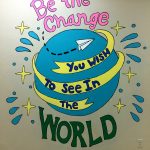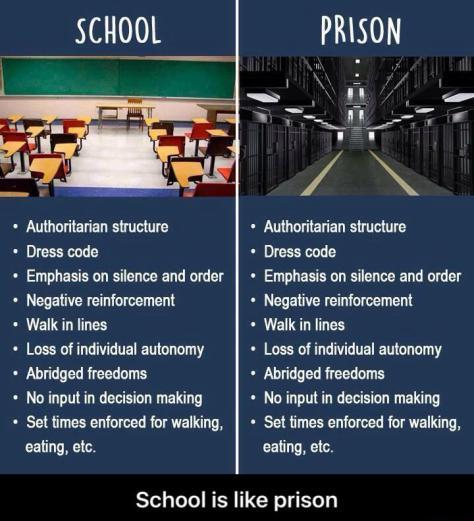
Last time we talked we explored the topic of education, its purpose, and how given our idealistic definition of education, America’s version may not add up. Today, we’re digging further into the design of the American education system, specifically, the message that the physical architecture is actively sending to students through its layout and structure. I should warn you before-hand, the message itself may shock you. Let’s get started.



School. What type of imagery comes to mind when you hear that word? Is it a bright and colorful playground, with lots of grass, and flowers, perhaps a vegetable garden? Is it sunny, well-lit classrooms, with big windows and sprawling plants? Maybe even a class pet? Do you think of brightly colored hallways and gorgeous murals? While this may be the image of school you cling to from your favorite childhood chapter books or your go-to nostalgic film, how well does this schoolyard utopia measure up to your real world experience of actually going to school?
For many people who attended traditional public schools, especially in under-funded inner cities or rural areas, the images that come to mind when one thinks of school may not be the most pleasant memories. There are flashbacks of walking into a large, dull, gray building. One with a leaky roof, asbestosis, infestation of mice and roaches, no heat in the winter or air conditioning in the summer. The school grounds were rocky and colorless, there was hardly any grass, if any, and instead of beautiful flowers, there were weeds, and bushes full of poison ivy. Inside the large grey box was no better. The hallways were stripped of all life, with lead-filled paint peeling from the walls, and hard, gray, cracked tiles on the floor. The classrooms were claustrophobic, and unwelcoming; the chairs were hard and cold, the posters on the walls have been stapled up there for the past decade, and all the seats face straight ahead, no room for any movement or flexibility. Ugly picture, right? But, if we’re being honest, how much more accurate were the images I just described compared to the ones you thought of in your head? Of course, not everyone had the experience of a school that looked like it had just been bit by a vampire, but way too many of us have, which begs the question, why? Why are our schools designed to look dull, suffocating, and hopeless? Why do American schools like, and feel, like prisons?

Given the descriptions of American public schools that we just talked about, and what many of us know about American prisons, either by documentaries, TV shows, or personal experience, it should come as no surprise to learn that the same people who designed prisons, also designed American public schools. Scarier still, American public schools are actually modeled, intentionally modeled, to look, and subsequently feel, like prisons. Many of the public schools in America today were built in the early 20th century. Before the 20th century, in the early 1830s, Massachusetts legislator and secretary of Massachusetts ’s Board of Education, Horace Mann began advocating for a universal educational system for all children; and thus, school as we know it today was formed (I highly encourage you to read the sources I have listed below, as I will not be covering the creation of modern-day education in full detail during this post.) . Shortly after the establishment of the modern-day American school, the United States government established the prison system in 1891 (Again, I highly encourage you to look at these sources on your own and read through them, as I will not be covering the creation of American prisons in detail in this blog post). Architect and academic leader Frank Locker, based mainly at the Harvard University Graduate School of Design, argues that very little, if anything, has changed in our fundamental design of public schools. “In a way,” says Locker in an interview last May with Arch Daily, “We are [still] replicating, literally, prisons, with no room for an integral, flexible, and versatile education.”
Design speaks. The way anything is laid out is intentional, meant to send a message to the audience. So what does the current design of public schools and its uncanny resemblance to prisons tell us about the message schools are indirectly conveying? Truthfully the message seems to be this: School, like prison, is a place of death. Death of creativity, death of ideas, death of curiosity, and perhaps most importantly, death of hope. American schools are designed as punishments, a place that actively rejects all things essential for a well-rounded education: freedom, flexibility, curiosity, and hope. There is, in many cases, literally, no room to grow, to change, to question. The lack of color and the claustrophobia of the classroom is actively telling students, “This is not a place to learn. This is not a place to explore. This is a place to obey.” Similar to prison, public schools are made to keep you obedient, submissive, and enslaved to a brutal system that is against the very purpose of education: hope.
Additional Sources
More from Rebecca Elliott here.
HPHR.org was designed by ComputerAlly.com.
Visit HPHR’s publisher, the Boston Congress of Public Health (BCPH).
Email communications@bcph.org for more information.

Click below to make a tax-deductible donation supporting the educational initiatives of the Boston Congress of Public Health, publisher of HPHR Journal.![]()